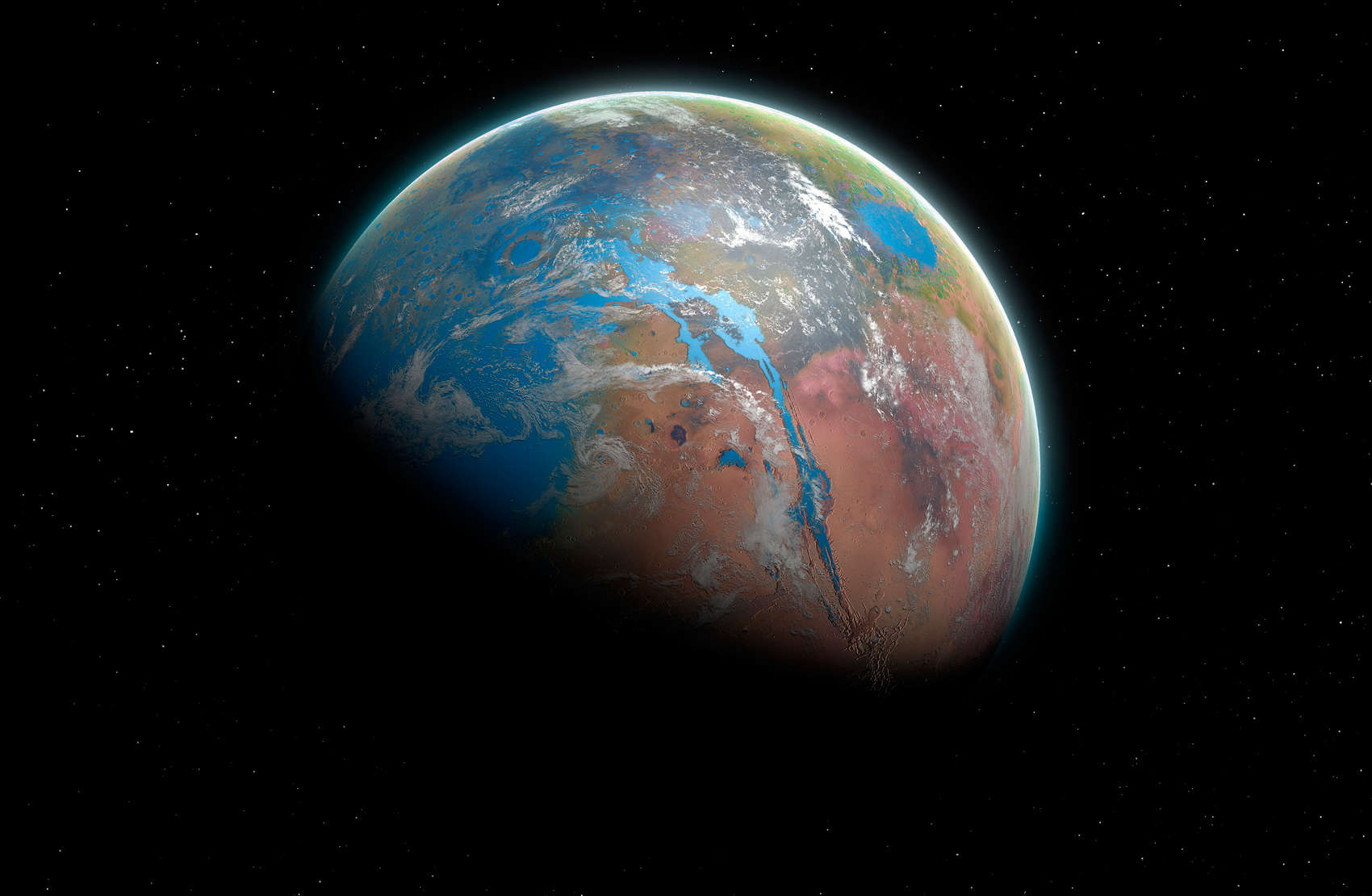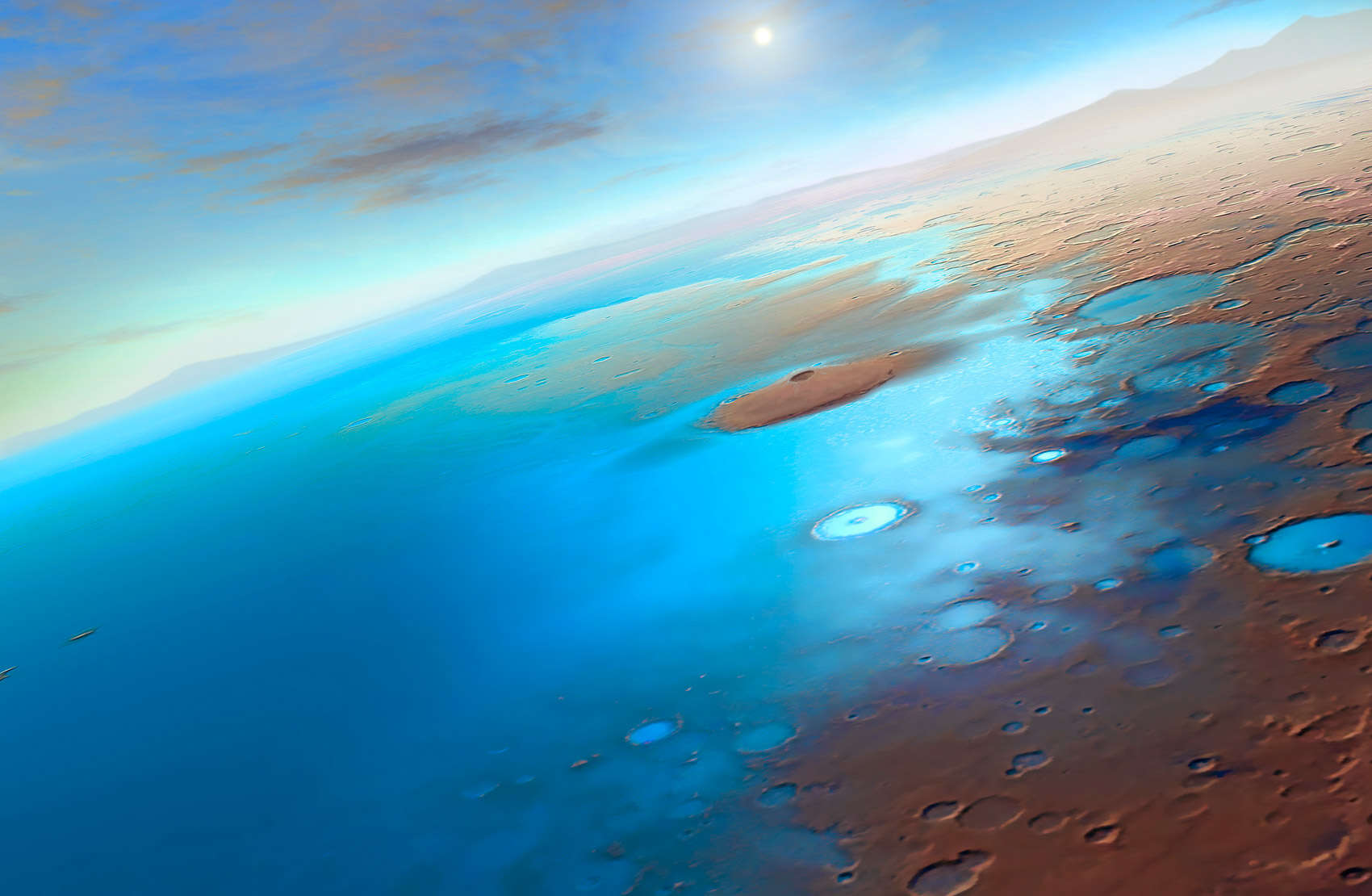Create a free profile to get unlimited access to exclusive videos, sweepstakes, and more!
Where did the waters of Mars go? Underground. Maybe Martian life did, too.

Mars today is pretty dry. The polar caps have water frozen in them, and there's some buried under the surface at mid-latitudes, but not a whole lot on a planetary scale; maybe enough to cover the entire surface of Mars to a depth of 20 to 40 meters.
Ancient Mars is another story. Billions of years ago there was a lot more. Estimates vary, but it may have been enough to cover the surface of the planet to a depth of 100 meters to as much as 1,500! Clearly, something dried Mars up.
Some of it evaporated and was eventually lost to space from the upper atmosphere, but it doesn't look like that process could've desiccated the whole planet. So what did? A new paper looking at various observations of the Red Planet indicates that a big chunk of the water — from a third up to a staggering 95% — was the victim of crustal hydration: The crust of Mars sucked it up. Or down, to be more accurate.
The key factor to this is the deuterium/ hydrogen (D/H) ratio. Deuterium is an isotope of hydrogen; an atom of regular hydrogen has one proton in its nucleus (really, the whole nucleus is just that proton), but deuterium has a neutron in there as well. That makes it twice as heavy as regular hydrogen, and that's a big deal.
In general, a bucket of water will have 1 deuterium atom for every 5,000 hydrogen atoms. If you let it sit, the lighter hydrogen atoms will evaporate more easily. Wait some amount of time, and the ratio of D/H will change, with more deuterium than you'd expect. In a sense, it's like a clock telling you how long that water was sitting out.
We know the current D/H ratio on Mars by looking at water in its atmosphere, and we can also see what it was like billions of years ago by looking at Martian meteorites, chucks of rock from Mars that fell to Earth after a large asteroid impact sent them into space. Sure enough, the meteorites show a lower ratio, meaning Mars used to have more water.
However, combining that information with how water escapes from Mars to space, that implies the amount of water on Mars long ago was around 50 – 240 meters depth if spread out over the whole planet, which is at the very lowest part of the range of 100–1,500 meters depth the geological evidence indicates. This in turn implies a lot of that ancient water is missing.
The scientists used a model of sources and sinks of water — places where water could come from, and places it could go — to try to figure out what happened. They based this on rover data, orbital measurements, and observations from Earth, and, long story short, the crust absorbed it. A lot of it. Up to 95%.
This would have happened during what's called the Noachian Period on Mars, from 4.1 to 3.7 billion years ago. To be clear, this doesn't mean there's an underground ocean like on Jupiter's moon Europa and Saturn's Enceladus. Instead, it got locked up into minerals, becoming part of their structure.
If this is true, it's a bit disappointing in some sense. There's a lot of water on Mars! Well, in Mars. But it's locked up in ways where it can't be released. Once it was absorbed, it took a one-way trip. A bit of a bummer if you want to find life on Mars.
… maybe. At the same time, astrobiologist Nathalie Cabrol, who is the Director of the Carl Sagan Center for Research at the SETI Institute, published what is essentially a science-based OpEd in the journal Nature Astronomy. In it, she argues that life on Mars may be all over the planet, saying that once it got started it could have spread to the whole planet via various methods before the water all went away (the article is behind a paywall, but this press release from the SETI Institute sums it up well).
She makes two overall points. The first is that we only have snapshots of what Mars was like in the past, and these are spread out over various places representing thin slices of time. So our viewpoint is a little skewed; a lot was happening on Mars pretty much anywhere you choose, and it's had a lot of time to makes changes. After all, the Sahara Desert here on Earth used to be lush with vegetation; you shouldn't judge a place for all time based on what you see now.
She goes into a bit of detail, but her point there is, as she writes, "Early life on Mars had the potential to spread and colonize globally." She points out that water existed all over the planet, there were several outlets for life to spread, and some of those outlets may yet exist today (such as recent volcanism, or cyclic thawing and freezing of water underground). And water may not be the only thing to look for; there are other patterns like soil pH and conditions that could shelter life from the otherwise harsh environment that could lead us to find "hidden oases" of life on Mars.
Her second point picks up from there, saying that if we want pristine samples of Mars to look for life we'd better get cracking. Humans will be there soon enough, and contamination is almost inevitable. We might be able to get samples from underground with properly sterilized tools and such, but we don't know how long it will take before our own interplanetary microbiome tries to make itself at home. We need to be extremely careful to install protocols to keep contamination minimized, both us to Mars and Mars to us (should extant life on Mars exist).
I think she makes a good point. We don't know if life still exists on Mars, but we don't know it doesn't, either. It's a wager with pretty high stakes. If we don't want to screw up our chance to seek out new life, then we need to think carefully about how we explore Mars. We can't just send a million people there to stomp around and ruin whatever scientific evidence might be found there, evidence with grand philosophical implications as well.
Mars isn't just some target, some light in the sky, some backup plan. It's a world. One just as old as Earth, that once had water and air and warmth and, perhaps, life. We need to make sure that is foremost in our minds as we proceed with its exploration.




























